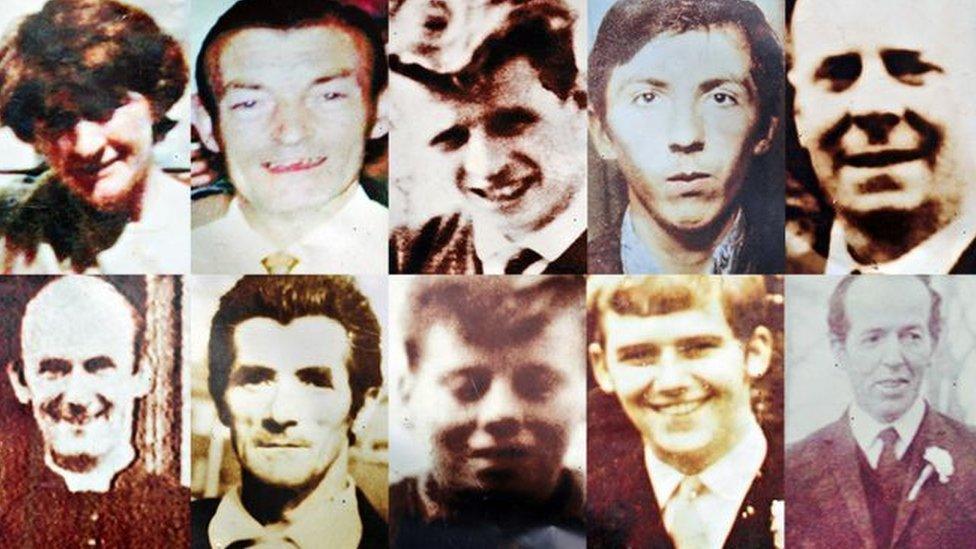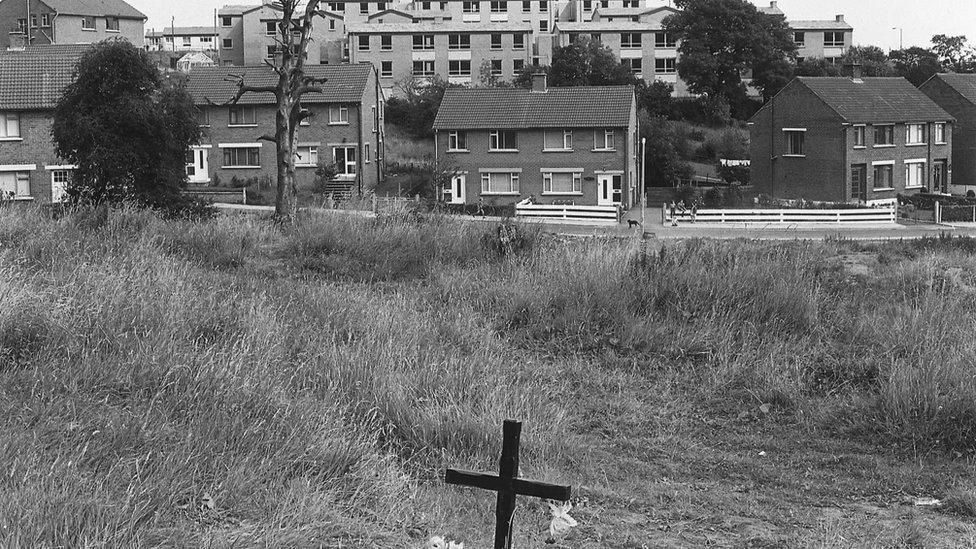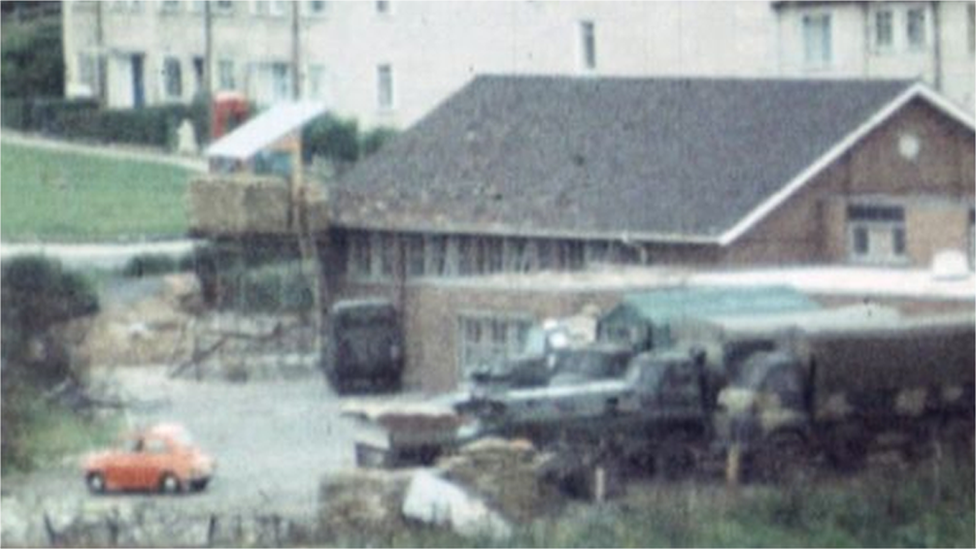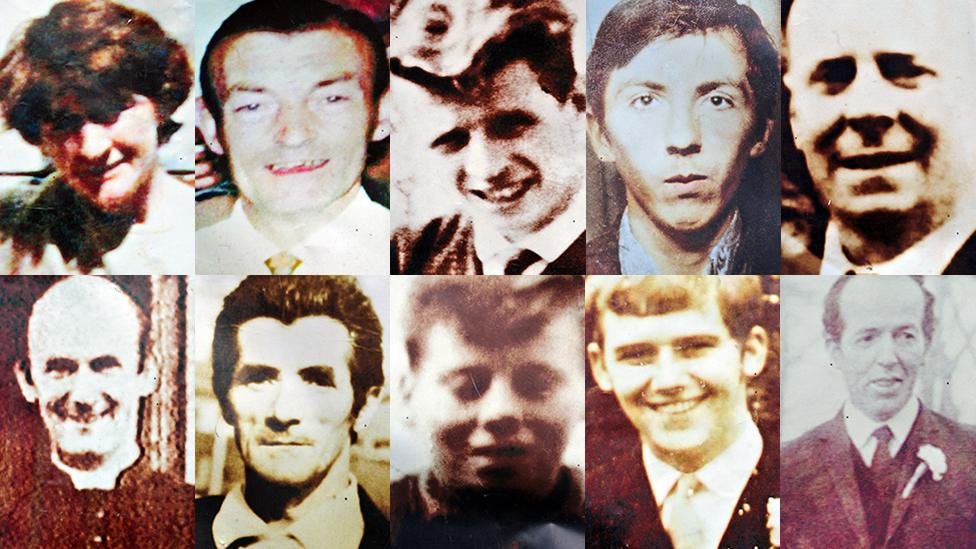Ballymurphy: 'UVF interlocutor' fails to show at inquest
- Published

The inquest is examining the deaths of 10 people in Ballymurphy in 1971
A so-called "UVF interlocutor" has failed to give evidence to the Ballymurphy inquest for the third consecutive time.
The value of his evidence was also brought into question in court.
Known as witness X, he was scheduled to give evidence before the coroner, Mrs Justice Keegan, on Wednesday but checks revealed that he was not present in court.
Witness X had been served with a notice requiring him to attend.
The coroner is now looking into whether he could, or should, be compelled to attend.
It had been understood that witness X had evidence obtained from people he referred to as UVF veterans about the shootings of some of the Ballymurphy victims.
The information he had offered to bring to the court stated that the UVF fired upon some of the victims using a Mauser rifle.
He first informed the Coroners Service of this in May 2018, and provided a statement to the coroner's investigators.
However, it was also revealed that witness X had got his information from several different sources which was relayed verbally to him, with no opportunity for him to make notes at the time.
A barrister for the coroner explained that a ballistics report had subsequently been compiled from the evidence provided so far, as part of a PSNI investigation into witness X's initial statement.
However, in an unexpected development, the court heard that the Mauser rifle "was not forensically linked to ballistics material available from the Ballymurphy deaths".
In other words, the Mauser rifle could not have shot any of the Ballymurphy victims.

The 1971 shootings took place during the introduction of internment without trial
However, there has been previous evidence in the inquest indicating that loyalist gunmen were in the Springmartin area on 9 August 1971, when two men were shot dead.
One soldier testified he had warned them that he would open fire if he became aware of them operating in the area.
Witness X had been granted anonymity to give evidence, but also demanded screening from the public gallery, from the next of kin, and from the legal representatives of the next of kin.
The coroner would not grant this, having granted such measures to no other witness.
This is understood to be why witness X will not appear.
'An interlocutor for an interlocutor'
In a lighter exchange in court, when it was suggested that a solicitor might give evidence on behalf of witness X, Mrs Justice Keegan said: "Well that's novel. An interlocutor for an interlocutor."
Barristers for the next of kin argued that it not be admitted at all, because it was "entirely untested and entirely unchallengeable".
The coroner said she would look at "what steps I can take in terms of punishing the witness for a breach of court direction".
Later, the court heard evidence by video link from Phil Russell who has lived in Canada since 1977.
He explained that as a 14-year-old boy he had run to Springfield Park during unrest on 9 August 1971, and witnessed the prolonged gunfire there later.
He testified that he believed two different Army units were firing at each other, with many people caught in the crossfire.
Mr Russell, now 62, is the brother of the late Gerard Russell who was shot and injured near the Henry Taggart base.
'Lots of people getting shot at'
Their brother, Robert, has given evidence to the inquest about two different shooting incidents.
Phil Russell only came forward to the inquest after he heard of the death of his brother earlier this year, and was informed that he could also give evidence.
He said he only realised how much his other brother, Robert, had seen when he saw a BBC News NI report.
"There were lots of people getting shot at that day," he said.

Soldiers from the Parachute Regiment were based at Henry Taggart Army base in west Belfast
"It never occurred to me that I would have the right to make a statement."
Phil Russell said he was taking shelter in the Springfield Park area with others when the deaths of Father Hugh Mullan and Frank Quinn took place on nearby waste ground.
He said the gunfire was coming from Army soldiers on the roofs of Springmartin flats and on nearby houses.
The witness said he was speaking to a man beside him who was hit and dropped to the ground.
Moans of the wounded
He then described being under fire and lying between two walls in the Moyard area along with a woman and two small children.
He was adamant that they all believed the soldiers were systematically trying to kill them.
Mr Russell also described listening to the moans of the wounded on nearby waste ground, and believes he listened to some of them slowly dying.
He said he and the others escaped when it got dark, and they helped carry a wounded man to a nearby community centre.
In his statement, he said he believed gunfire from soldiers in Springmartin struck an apartment building in Moyard, and some rounds carried on towards the Army base some distance behind it.
This, he said, caused the soldiers in the base to return fire towards the same apartments, with some bullets passing on back towards Springmartin.
He felt the two units of soldiers had continued to fire inadvertently at each other for some time.
A barrister for the Ministry of Defence (MOD) suggested that the locations Mr Russell identified would not have caused the soldiers to fire at each other.
- Published11 May 2021

- Published13 November 2018
